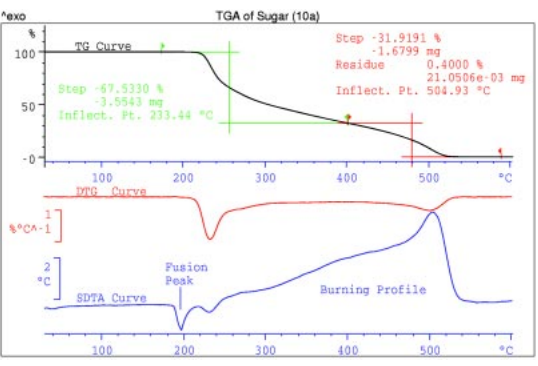TGA of Sugar and Starch
Sample
Sugar (saccharose), corn starch
Conditions
Measuring cell: TGA/SDTA851e
Pan: Alumina 70 µl, no lid
Sample preparation: If sugar is heated at a rate of 10 K/min it foams up during decomposition and may leave the pan. The addition of approximately 20 mg dry alumina powder helps to keep the sample in the pan. Sample weights: 5.26 mg sugar, 4.99 mg starch
TGA measurement: Heating from 30 °C to 600 °C at 10 K/min
Atmosphere: Nitrogen, 50 cm3 /min

Interpretation
The flat part of the TGA curve up to 200 °C proves that there is no moisture in the sugar (< 0.1%). The first process that occurs is melting at 190 °C, which is only visible in the SDTA curve. In the liquid phase the carbohydrate loses water and caramelizes. Stoichiometrically, from the formula Cn(H2O)n one expects the formation of 60% water and 40% carbon black. But, there is no distinct dehydratation step because of concurrent other reactions.

Evaluation
The DTG minimum is normally used as the evaluation limit to separate overlapping steps. The dehydratation step of 67.3% is close to the above mentioned value of 60%. The carbon black formed burns exothermicly up to 540 °C. The shape of the SDTA curve is called the ‘burning profile’ and gives an indication of the reactivity of the carbon black. The residue of 0.40% at 590 °C is the mineral ash content.
Interpretation
Starch contains several percent moisture depending on the relative humidity of the surrounding air. The moisture is eliminated up to 200 °C. Stoichiometrically from the formula Cn(H2O)n one expects 60% water and 40% carbon black. Again, there is no distinct dehydratation step because of concurrent other reactions.
Evaluation
The DTG minimum is used as the evaluation limit to separate overlapping steps. There is 9.2% of moisture detected. The next step of 67.9% is higher than the value expected of 60%. The carbon black formed burns up to 540 °C. The residue of 0.19% at 590 °C corresponds to the mineral ash content.
Conclusion
TGA/SDTA allows the determination of the moisture content, the content of active ingredients and the ash content. In addition, the melting point and the TGA inflection temperatures are used to identify the different carbohydrates.
TGA of Sugar and Starch | Thermal Analysis Application No. HB 1016 | Application published in METTLER TOLEDO TA Application Handbook Food